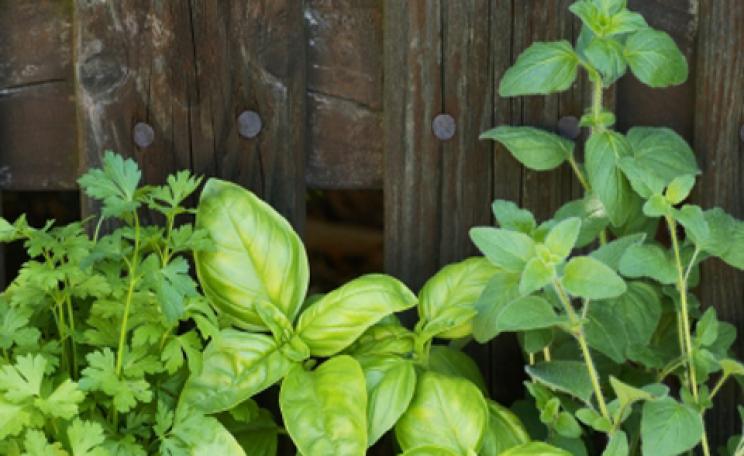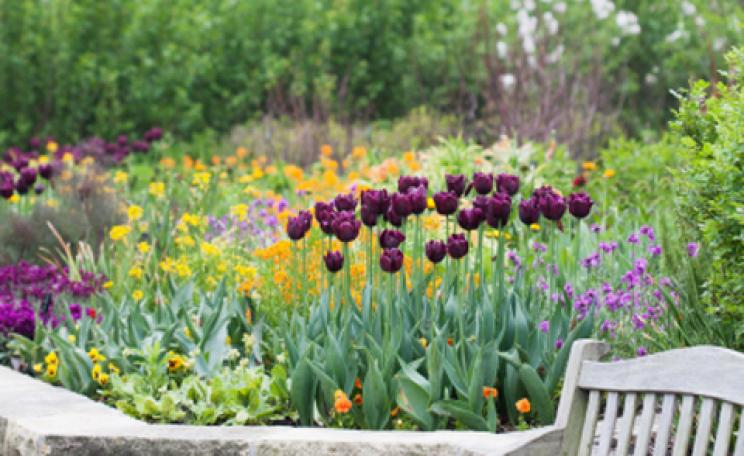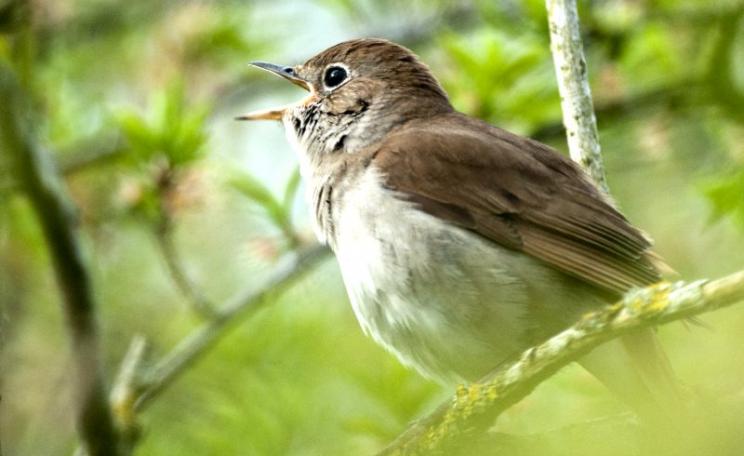The definition of a herb is a plant that has a practical use. Herbs have been grown for centuries to provide things like food flavouring, preservatives, nutrition, medicines, spells, perfumes, skin and hair preparations, fabric dyes, cleaning agents and poisons. Today we mainly use herbs for cooking and paid the supermarkets a whopping £50 million for them in 2009. But why not grow your own? Snipped straight from the plant they’re tastier, more nutritious and a lot cheaper. Plus with your own herb garden, you can grow all sorts of interesting plants that the supermarkets don’t stock, such as perilla, which is used in Japanese cooking.
Herbs are also great for home remedies. If someone has an upset tummy, you can nip outside and pluck some fresh peppermint to make a restorative tea, while insomniacs can try soaking in a hot bath infused with chamomile. But herb gardens have the reputation of being an eyesore: a sea of sprawling, straggly plants grown for use rather than beauty. But just because herbs are practical doesn’t mean they have to look ugly. There are plenty of pretty herbs around and with a clever design, your herb garden will look a picture.
 The urban herb garden
The urban herb garden
For formal elegance, plant your herbs in what the French call a parterre. Designed to be seen from above, a parterre is a symmetrical pattern formed of flowerbeds, herb beds and topiary. Each bed is cut out to form a pattern with the others - that might be something as simple as four square beds or something much more elaborate. Border your herb beds with neatly clipped low evergreen hedges of box (Buxus sempervirens) or box-leaved holly (Ilex crenata). A quadrant of standard bay trees creates more evergreen structure and the leaves can be used for cooking. Intersperse your herbs with decorative plants for pools of colour. Burgundy contrasts beautifully with the green leaves of the herbs – try planting the maroon Queen of Night tulip and Tuscany Superb rose. White always looks elegant, so you could opt for white-flowered herbs or plant patches of white foxgloves through the herb garden.
The herbs themselves can look gorgeous too. The enormous Angelica archangelica (whose stems can be used for baking or stewed with rhubarb) has an imposing architectural beauty that looks great in a contemporary setting. The burgundy angelicas, Angelica sylvestris 'Vicar's Mead' and Angelica gigas, aren’t edible but they look stunning. Intersperse with the bronze fennel Purpureum, which is edible and scrummy with fish. Herbs are extremely useful in a city garden. You can even create your own ‘urban manure’ by growing comfrey (Symphytum officinale). Comfrey is used as a potassium-rich mulch or liquid feed and can also be added to the compost heap to add carbon and speed up decomposition. It has pretty pink and purple flowers, but can become invasive, so keep thinning it. You can also grow herbs for homemade beauty products. Rose petals can be heated in water to create a toner and chamomile flowers can be steeped in hot water to make a brightening hair rinse for blondes. If you don’t have much space in your city plot, you can still grow herbs – most will thrive in pots and window boxes if watered regularly.
 The country herb garden
The country herb garden
The country herb garden, whether in the country or not, is a more romantic, informal affair. Your herb borders might be enclosed by a low hedge of rosemary (delicious with potatoes and root vegetables) or lavender, which can be used in baking or put into muslin bags to perfume your clothes drawers. The border might contain a floppy jumble of herbs, such as borage (Borago officinalis) and chicory (Cichorium intybus), which both have beautiful blue flowers. Young chicory leaves are a good addition to a summer salad while borage flowers have a cucumber flavour and they look and taste spectacular in a glass of Pimm’s. Plant as much marjoram as you can and your garden will be aflutter with butterflies, which flock to the tiny pink and white flowers. The best ones for cooking are sweet marjoram (Origanum majorana), which should be grown as an annual, and Origanum vulgare 'Gold Tip'. If you like traditional Italian tomato sauce, marjoram is a must. Other lovely country bumpkin herbs are thyme (Thymus vulgaris) and chives (Allium schoenoprasum), which both bloom pink flowers in summer and look great at the front of a border.
Lovage (Levisticum officinale) and lemon verbena (Aloysia citrodora) are great backbone plants for the herb garden because they provide foliage and height. Lovage (or ‘love parsley’) is a hardy perennial with big lush leaves that grow up to two metres tall. It has a celery flavour that is delicious in salads, soups and stocks. Lemon verbena reaches one and three metres in height and is also a perennial, but will need mulching over winter to protect it from frost. The leaves make a soporific tea, which should be supped last thing at night to tackle insomnia. Last but not least, every country herb garden needs some chamomile. This adorable herb releases a honey apple scent into the air when trodden upon. A chamomile lawn is possible but hard to maintain. It’s far easier to plant plugs of chamomile into a grass lawn or in between paving. The flowers can be used to brew a relaxing cuppa.
 Herbs for the pantry
Herbs for the pantry
*Basil (Ocimum basilicum) One of the best tastes of summer is a mouthful of fresh basil, tomato and olive oil. Basil also makes pesto to eat with pasta. Sow annually in spring in a greenhouse before planting out (or sow in situ in warmer weather); basil likes rich, well-drained soil in sun. Water regularly in the morning (never the evening) and keep picking the leaves to stimulate fresh growth.
*Mint (Mentha spicata var. crispa ‘Moroccan’) Moroccan mint is wonderful in many sweet and savoury dishes. Apple mint (M.suaveolens) is nice in salads and with new potatoes. Both Moroccan and peppermint (M. x piperita) make lovely fresh mint tea. Grow in moist soil in semi-shade. They are invasive perennials so grow them in containers or sink a plastic pot into the ground. Keep cutting it down to prevent flowering.
*Parsley (Petroselinum crispum var neapolitanum) Flat-leaf parsley is a pantry essential, adding to flavour to all sorts of savoury meals. Sow annually in late spring in a greenhouse (in plug trays as it loathes root disturbance) or in situ in rich, moist soil in semi-shade. Protect from slugs and plant near onions or garlic to prevent carrot fly attack. Can also be grown in pots on the kitchen windowsill.
*Coriander (Coriandrum sativum) Delicious in salads and sprinkled on top of Middle Eastern and Indian dishes. Sow annually in spring, into plug trays in a greenhouse before planting out, or in situ in warmer weather. It likes well-drained, rich soil and a sunny spot; water regularly in the morning. Keep cutting to stop it flowering. Sow every month from spring to have a continuous supply.
*Chervil (Anthriscus cerefolium) Looks like small cow parsley and is indispensible in French cooking. It has a gentle aniseed flavour that compliments salads, omelettes and fish. Sow two or three times during the year, in plug trays in the greenhouse (or in situ when it’s warmer). Chervil likes a light, moist soil in semi-shade. It is hardy and will keep growing through the winter under a cloche. Remove all flowering stems.
*Sage (Salvia officinalis) Grows all year round and is synonymous with warming winter dishes. In Italy sage and butter are cooked gently and poured over ravioli or potatoes. It is an evergreen perennial that should be grown in well-drained soil in sun. Cut stems back every spring and replace (or propagate) the plant when it becomes woody (after about five years).
*Summer Savoury (Satureja hortensis) A fiery little herb that tastes wonderful with Puy lentils or haricot beans. Use it sparingly as it has a strong peppery taste. Sow in the greenhouse annually in spring and then plant out in well-drained soil in sun. Sow in situ in warmer weather. Keep picking the leaves to stop it becoming leggy and don’t let it flower. It is supposed to prevent flatulence.
*Dill (Anethum graveolens) Essential in Scandinavian cooking and heavenly with salmon. Sow annually in spring into plug trays and plant out in well-drained soil in sun; sow in situ in warmer weather. Don’t feed (they like it rough), don’t plant near fennel (it may cross-pollinate) and don’t let it self-seed (it will become a weed). Dill produces umbels of sun yellow flowers that are worth growing for looks alone.
Useful links
Super suppliers:
Jekka’s Herb Farm, 01454 418878, www.jekkasherbfarm.com
Arne Herbs, 01275 333399, www.arneherbs.co.uk
Tamar Organics, 01579 371182, www.tamarorganics.co.uk
Brilliant books:
Grow Herbs by Jekka McVicar (Dorling Kindersley)
Drugs in Pots by Anne McIntyre (Gaia)
Ultimate Natural Beauty Book: 100 Gorgeous Beauty Products to Make Easily at Home by Josephine Fairley (Kyle Cathie)
| READ MORE... | |
 |
GREEN LIVING What is a seedbomb? In an exclusive extract from her new book, Seedbombs: Going Wild with Flowers, author and gardener, Josie Jeffery, explains the seedbomb phenomenon |
 |
GREEN LIVING Super nature: creating a wildlife garden From birds to dragonflies and butterflies to bees, Hazel Sillver explains how to turn your garden into a haven for wildlife |
 |
GREEN LIVING Top 10… self-sustainability courses and workshops Be it chicken keeping, foraging or organic gardening, if it's the good life you want, there’s a course out there for you. Tom Antebi rounds up some of the best |
 |
GREEN LIVING Help save Britain’s birds From buying a nest box to keeping Mr Bigglesworth under control; there are plenty of ways in which you can help the UK’s bird population |
 |
GREEN LIVING Soil Stained Survivors: how gardening is helping those caught up in the Balkan wars For over a decade, a pioneering project in Bosnia and Herzegovina has been transforming war torn lives through the power of plants. But now their money has run out. Helen Babbs meets the gardeners facing up to an insecure future |








